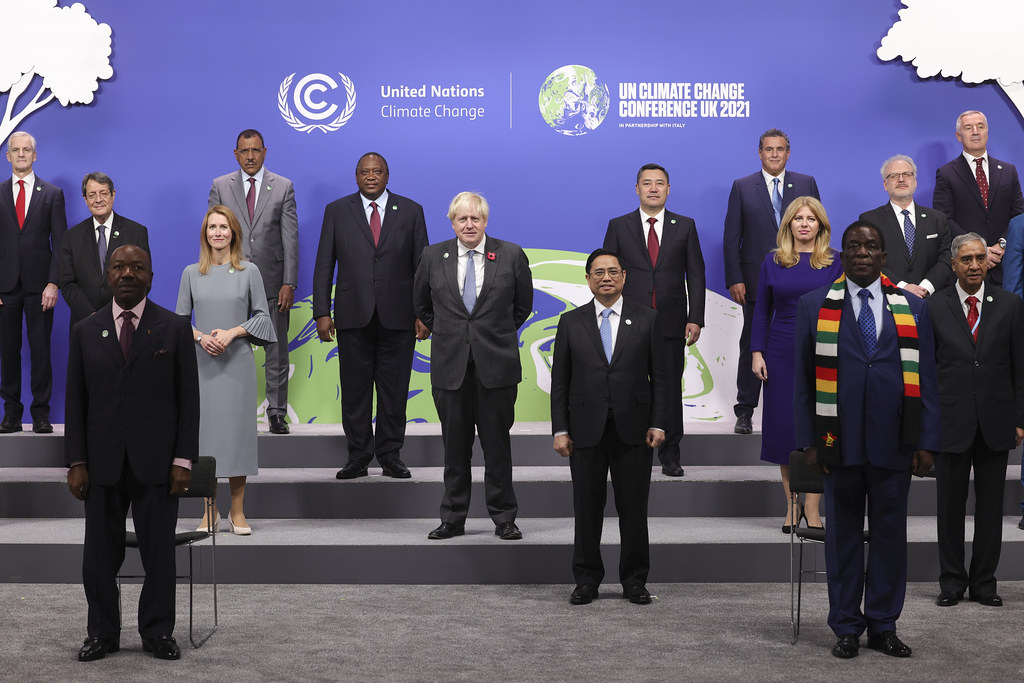Key Takeaways From the Glasgow Climate Pact
Here are some of the key takeaways and surprises from the Glasgow Climate Pact.

Published by The Lawfare Institute
in Cooperation With

Nearly 200 nations signed the Glasgow Climate Pact on Nov. 13. Acknowledging the increasingly strong connection between climate change and its role as a threat accelerant, the pact explicitly states that climate change is a “social, economic and environmental threat.” It also called on world leaders to “strengthen the global response to the threat of climate change.”
Climate change is the ultimate environmental and security destabilizer, exacerbating extreme weather, drought, wildfires, and sea level rise. Climate change is already destabilizing many parts of the world. This new climate-security reality was brought home just last month in the U.S. National Intelligence Estimate and other U.S. climate-security reports. Reducing greenhouse gas (GHG) emissions from human activity is now inextricably linked to broader security concerns.
The Glasgow Climate Pact consists of 94 paragraphs and eight thematic subparts. In what follows, I highlight the key takeaways, some surprises, and what to look for in the future.
- The Rise of “Mitigation Ambition.” Since the U.N. Framework Convention on Climate Change was negotiated in 1992, international negotiators have focused on mitigation—reducing each nation’s GHG emissions pumped into the common atmosphere. The Glasgow Climate Pact provides a shot in the arm to global mitigation efforts. Paragraph 29 accelerates the timeline for nations to strengthen their mitigation plans—known as nationally determined contributions—by the end of 2022. The Paris Agreement envisioned that these updates would take place every five years, so this expedited timeline was hailed as a key Glasgow achievement. Still, while plans are important, implementation and execution will determine future climate progress. All eyes will be on COP27 in Egypt next year to examine these plans and assess what actions have been taken since Glasgow.
- The Mission to “Keep 1.5 Alive” Is on Life Support. The 2015 Paris Agreement sought to limit the global temperature increase to 1.5 degrees Celsius (2.7 degrees Fahrenheit) above preindustrial levels and keep the global temperature increase “well below” 2.0 degrees Celsius (3.6 degrees Fahrenheit). Exceeding this threshold leads to irreversible, catastrophic harm. The National Intelligence Estimate stated that the world is well off-track to meet the Paris Agreement’s goals. While the Glasgow Climate Pact keeps the 1.5 goal alive, it is hanging by a thread. To have a chance of meeting this 1.5 goal, the world has just 98 months to cut worldwide GHG emissions in half. That’s not impossible, but it will require transformational action this decade.
- Increased Focus on Adaptation Finance. Climate adaptation is broadly defined as modifying behaviors or systems in the face of climate change. This includes investing in climate-resilient infrastructure or retreating from climate-exposed coastal or wildfire zones. Significantly, the Glasgow Climate Pact has a separate section on adaptation finance, stating that the “current provision of climate finance for climate adaptation remains insufficient to respond to worsening climate change impacts in developing country Parties.” It also urges (not requires) wealthy, developed nations such as the United States to double their climate adaptation support to developing nations. While not insignificant, this exhortation is neither legally binding nor sufficient to tackle future climate disasters. By their own accounting, U.N. experts estimate that the world must spend up to 10 times more than present levels to help developing nations adapt to climate change.
- The Coal “Phase-Down.” As part of the pact’s broader mitigation efforts, Paragraph 36 calls upon parties to accelerate efforts “toward the phase-down of unabated coal power and inefficient fossil fuel subsidies.” The calling out of both coal power and fossil fuel subsidies is a departure from prior U.N. climate agreements, which spoke more generally of drawing down GHG emissions. But the language here is significant. The initial text used the term “phase-out,” but this was changed to “phase-down” at the insistence of China and India—two nations whose economies are heavily dependent on coal power for economic growth. Further, the Glasgow Climate Pact does not reference oil or natural gas as part of this phase-down. Will oil and gas companies view this omission as an invitation for further extraction or a warning shot to embrace sustainability? One of the lingering questions after Glasgow is how fossil fuel companies will respond to the phase-down of coal and removal of fossil fuel subsidies.
- Minimal Progress on Loss and Damage. Tragically, developing nations contribute the fewest GHG emissions but have historically suffered the most from climate impacts. The Glasgow Climate Pact addresses this inequitable climate reality in Paragraph 50
Acknowledg[ing] that climate change has already caused and will increasingly cause loss and damage and that, as temperatures rise, impacts from climate and weather extremes, as well as slow onset events, will pose an ever-greater social, economic and environmental threat.
Wealthier, developed nations are more likely to have the resources to rebuild following extreme weather events and other climate-related disasters. Following Hurricane Ida, for example, the Federal Emergency Management Agency funneled more than $800 million in federal funding to affected communities in the U.S. But what are developing nations without the resources of affluent, developed nations to do?
The Paris Agreement first attempted to address this disparity via what is known as loss and damage. Many observers hoped that Glasgow would breathe life into these provisions through concrete financial commitments, but this did not occur. To the disappointment of many, the Glasgow Climate Pact addressed loss and damage through the establishment of a “dialogue” between parties to “minimize and address loss and damage associated with the adverse impacts of climate change.” Developing nations sought a “facility” that would set in motion more concrete financial commitments to compensate for climate harm.
The move away from a loss and damage “facility” to a “dialogue” showcases that developed nations are reluctant to commit to anything that may be perceived as climate reparations. So what is the responsibility of rich countries to the poorer countries that contributed the least to climate change and will suffer the most from climate impacts? This question will take on increased importance, particularly as advances in climate attribution science make the linkage between climate change and climate impacts unassailable.
- Continual Trust Deficit Between Developed and Developing Nations. More than a decade ago, developed nations pledged $100 billion annually by 2020 to assist developing nations in transitioning to greener economies. This promise also fell short. The Glasgow Climate Pact highlights this failure “with deep regret” while urging greater clarity and transparency as developed nations will not follow through on this financial commitment until 2023.
- The Surprise China-U.S. Pact. As I have argued before, any substantive climate progress increasingly leads through China, which accounts for nearly a third of all current GHG emissions. In a joint declaration issued during the Glasgow negotiations, China and the U.S. agreed to take steps on a range of issues, including methane emissions, transition to clean energy and decarbonization. Will the U.S. and China be able to overcome their differences in other contentious areas—trade, Taiwan’s future and the South China Sea—to meaningfully follow through on this declaration? That is not clear, but observers should welcome any progress from the world’s largest historical emitter (the United States) and the largest current emitter (China).
- The Tragic Plight of Small Island Developing States: For many small island nation-states, climate change is the defining security issue. Twenty percent of some island nations’ landmass will disappear by 2040, and climate scientists estimate that climate change-driven sea level rise and wave-driven flooding will cause four atoll nations to disappear this century. The Maldives representative highlighted the tension between incremental international climate diplomatic efforts and the urgency her island nation is facing: “What is balanced and pragmatic to other parties will not help the Maldives adapt in time. It will be too late.”
- A New Deforestation and Methane Pledge: Outside the Glasgow Climate Pact, 120 nations representing 90 percent of the world’s forests pledged to halt deforestation by 2030. Forests such as the Amazon River Basin serve as the lungs of the planet, soaking up carbon emissions. And U.S. leadership was critical to locking in 100 nations to a Global Methane Pledge, whereby nations agreed to cut methane emissions by 30 percent by 2030.
Where Do We Go From Here?
First, observers should keep an eye on the private sector’s response to the Glasgow Climate Pact. Fossil fuel companies may well view the pact as a signal that they need to diversify their business lines soon and move away from fossil fuel extraction. But oil and gas remain lucrative, particularly with high gas prices in the U.S. and beyond. Second, the U.S. is considering passing landmark climate legislation—Build Back Better—that could provide another shot in the arm for climate efforts. Third, the issue of climate reparations via the loss and damage dialogue is not going away. Loss and damage discussions may take center stage as developing nations continue to suffer from climate harm. I anticipate that pressure will build to fund a loss and damage facility as calls for climate justice grow louder and affluent nations are pressured to make amends for past, present and future climate damage. Outside of loss and damage funding, the U.S. military is preparing for climate risks at home and abroad and will be called upon to respond to climate-exacerbated disasters.
Finally, the Glasgow conference saw 100,000 climate protesters take to the streets outside the convention hall. Yet, the next two climate conferences will take place in locations where it will be more difficult to duplicate these protest efforts. COP27 will take place in Egypt in 2022, and COP28 will take place in the United Arab Emirates (an OPEC member) in 2023. Egypt has passed legislation restricting peaceful political demonstrations, so it is difficult to envision a similarly sized climate protest effort unfolding in Sharm el-Sheikh, the resort town that will host COP27. Regardless of how these next two COPs unfold, it is increasingly clear that what happens outside the COP negotiations can and will influence the negotiations inside. Whether this pressure will be enough to prompt transformational action to halve global GHG emissions this decade remains to be seen.





